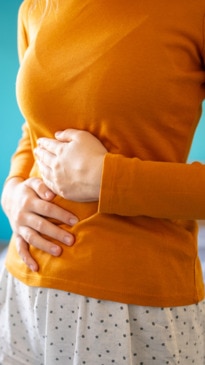A FODMAP diet could ease symptoms of endometriosis, research shows
Could symptom management be as simple as a diet change?

Lifestyle
Don't miss out on the headlines from Lifestyle. Followed categories will be added to My News.
For many people living with endometriosis, treatment doesn't provide much pain relief. Researchers believe a diet change could be crucial to pain management.
Endometriosis comes with a slew of painful and uncomfortable symptoms, including inflammation, bloating, constipation and nausea.
Pain relief treatments don’t even touch the sides of many patients’ pain, leaving them to miss commitments.
One study found that more than 67 per cent of women missed work or school or weren’t able to perform daily activities due to their pain level.

After being a neglected area of research for years, the chronic condition is finally getting more attention and funding, resulting in new diagnostic tools, treatments and management plans being looked into.
The latest finding? A link between a common diet and eased symptom severity.
The low FODMAP diet
The Low fermentable oligosaccharides, disaccharides, monosaccharides and polyols (FODMAP) diet is recommended for people with irritable bowel syndrome (IBS) as a way to reduce the severity or frequency of uncomfortable symptoms, including cramping, stomach pain, bloating, gas, and other digestive issues.

FODMAPs are sugars that the small intestine struggles to absorb, so reducing the amount of foods containing these can alleviate symptoms.
Ingredients such as garlic, dairy, onions, apples and wheat are often eliminated, and gradually reintroduced at a later date.
Diet as a pain management tool for endometriosis
Researchers from Monash University have found that following the diet eased endometriosis symptoms such as abdominal pain, bloating and abnormal stool consistency.

They studied 35 women aged 18 and older with diagnosed endometriosis and gastrointestinal symptoms as they followed their usual diet for seven days before switching to either a low FODMAP diet or another diet based on Australian Healthy Eating Guidelines. The second diet had the same macronutrients, micronutrients and fibre content as the low FODMAP diet.
The women then ate in line with their usual diet for another 28 days, before swapping to the alternate diet.
Senior research dietitian Dr Jane Varney said there is an overlap of gastrointestinal symptoms in people with endometriosis and IBS, and that the diet could be beneficial in treating both.

“Six out of 10 patients responded to the Low FODMAP Diet and reported clinically significant improvements in gastrointestinal symptoms,” she said.
“Abdominal pain and bloating improved, stool form normalised and quality of life improved. Given the high prevalence of gastrointestinal symptoms among women with endometriosis, and the absence of targeted treatments, this study highlights a diet therapy that will bring symptom relief to many women.”
In the recently updated guidelines for the diagnosis and treatment of endometriosis, experts suggest that ‘clinicians discuss diet advice (FODMAP diet) and dietary supplements (fish oil and vitamin D) with people with endometriosis to manage pain symptoms’, but note that there is limited evidence to say for certain that these dietary changes could help with pain management.

Varney noted that this research showed for the first time that the diet reduces the severity of gastrointestinal symptoms associated with endometriosis, while the study’s senior author, Rebecca Burgell said, “gastrointestinal symptoms associated with endometriosis are largely ignored in clinical guidelines”.
“Most endometriosis guidelines fail to mention gastrointestinal symptoms and none offer advice about identification or management. Nor do IBS guidelines mention screening for endometriosis”, she added.
More Coverage
Originally published as A FODMAP diet could ease symptoms of endometriosis, research shows





